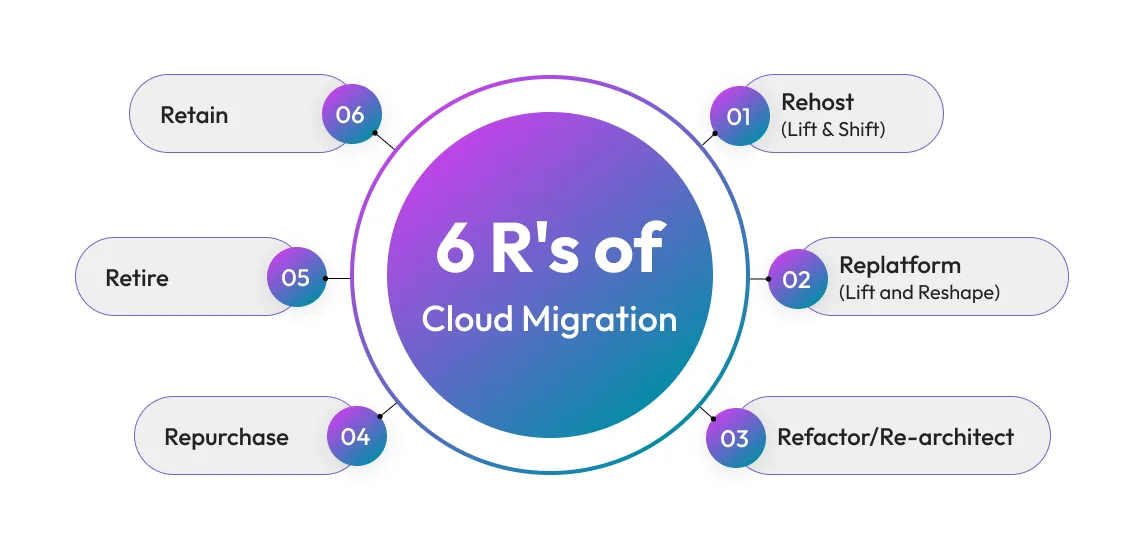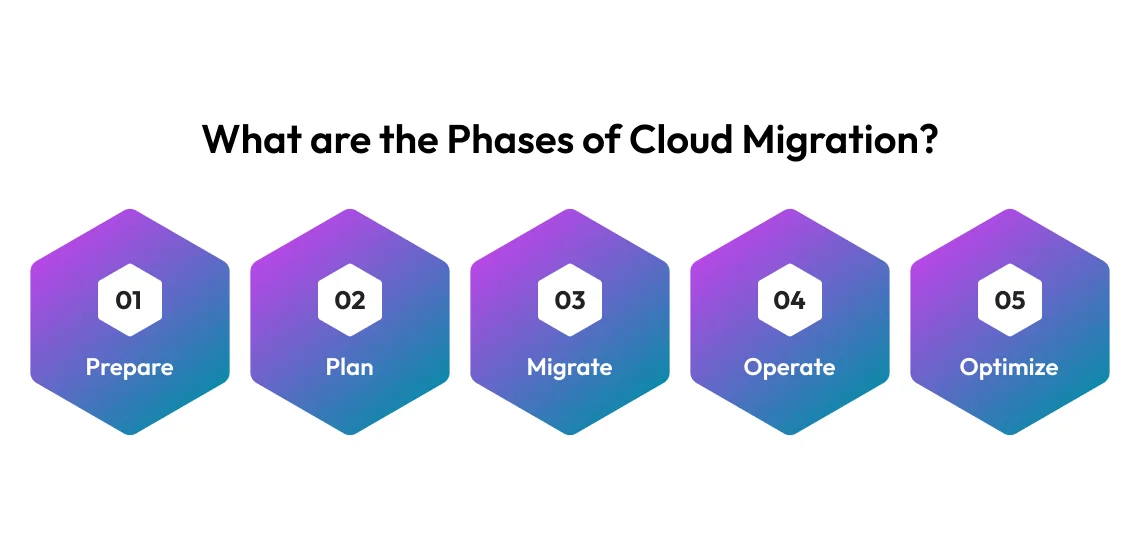Cloud Migration Strategy: The Comprehensive Guide
- DevOps
- June 28, 2024
Cloud migration is powering the digital transformation of most businesses across industries. However, many businesses still face difficulties in cloud migration. This blog will help you understand the importance of having a well-defined cloud migration strategy, along with various strategies, phases, and best practices to ensure a seamless transition to the cloud.
Over time, business areas have increasingly recognized the cloud’s value proposition, especially during events like the pandemic and the acceleration of digital transformation services.
In enterprise technology, the cloud has become the largest value enabler. An analysis of cloud adoption by Forbes Global 2000 companies, conducted by McKinsey, reveals that these companies could collectively generate approximately $3 trillion in value from using cloud-based solutions by 2030.
The increasing adoption of the cloud is evidenced by the growth of cloud engineering services and spending on cloud infrastructure. Global spending on cloud infrastructure is forecasted to reach $1.35 trillion by 2027, with a compound annual growth rate (CAGR) of 19.9% for the forecast period from 2023 to 2027, as mentioned in cloud computing statistics
. This trend is expected to continue in the coming years as more enterprises become aware of digital transformation and the role cloud migration plays in it.
To successfully adopt cloud technology, enterprises must begin with a tailored cloud migration strategy that aligns with both their cloud transition goals and business requirements. So, let us understand more about cloud migration strategy in detail.
What is a Cloud Migration Strategy?
A cloud migration strategy is a well-defined plan and approach for transferring data, applications, IT processes, services, or any digital assets/resources from existing on-premises or co-located infrastructure to the cloud.
These strategies address the critical question of how to move your digital assets to the cloud. Since every business has unique reasons and requirements for migration, there cannot be a one-size-fits-all migration plan.
However, having a strategy in place provides crucial assistance during the migration. These strategies are commonly referred to as the 6 R’s strategies.
Before diving into these strategies, let’s understand why having a cloud migration strategy is beneficial. Here are the benefits of cloud migration strategies:
- Brings all team members on the same page, ensuring everyone understands the objectives and goals
- Minimize the possibilities of disruptions during the migration
- Prepares the organization for unforeseen issues with comprehensive risk mitigation plans.
- Improves collaboration and integration across various business units.
- Ensures that security measures and compliance requirements are addressed
- Ensures optimal use of cloud resources
- Includes ongoing optimization and monitoring plans, extending beyond the migration itself.
- Cause minimal disruption to business operations, reducing downtime and maintaining business continuity.
6 Cloud Migration Strategy
For this, most businesses adopt one or a combination of the popular 6R cloud migration strategies based on what’s suitable for their requirements. Let’s explore these cloud migration strategies in detail.

Rehost (Lift and Shift)
Also known as “lift and shift,” the rehost cloud migration strategy involves “lifting” your existing data assets from your current infrastructure and “shifting” them to the cloud. Since the existing data set is replicated and transferred to the cloud, this migration causes minimal changes to the architecture, ensuring continuity without the immediate need for reengineering.
When to use the rehost cloud migration strategy:
- Ideal for non-critical applications with a simple architecture
- Suitable for migrating difficult-to-modify legacy systems
- Leverages the cloud without the immediate need for re-architecting applications
- Useful when there is a need to move to the cloud rapidly with minimal disruption
Though this strategy enables your business to benefit from minimal downtime and the least complex migration, you would not be able to leverage cloud-native features like scalability and elasticity since the application would run just as it does in the on-premises infrastructure.
Given the involvement of minimal modifications, it would incur lower upfront costs, but you may not be able to optimize resource utilization, which could lead to higher costs in the long run.
Replatform (Lift and Reshape)
Unlike the previous strategy, if you are looking to make some modifications or optimizations(mostly configurational) to the application without changing its core architecture to improve its performance in the cloud, then re-platforming is the right strategy for you. These optimizations could include upgrading databases, changing middleware, adjusting configurations, and more.
When to use the replatform cloud migration strategy:
- Suitable for applications that need better scalability and flexibility
- Need to make improvements to your application to enhance performance
- Want to leverage cloud-native features like managed services, auto-scaling, and more
Replatforming would enable you to leverage various native-cloud features that enhance your application’s performance and scalability but may not unlock the full potential of the cloud for complex applications.
Refactor/Re-architect
Refactoring enables you to make significant changes or even completely redesign your existing application architecture to maximize cloud benefits such as scalability, resilience, and cost efficiency. This strategy goes beyond rehosting and platforming as it allows you to fully utilize cloud-native features and capabilities like microservices architecture, serverless computing, and more.
When to use the refactor cloud migration strategy:
- When maximizing scalability, performance, and agility are crucial
- Organizations aiming to optimize costs over the long term
- Suitable for applications with complex architectures
- Ideal for applications that require significant modernization
By allowing the redesign of your application, it enables significant improvements in various aspects such as performance, responsiveness, adaptability to changing needs, and more. However, it is a complex strategy that involves a substantial amount of time and cost.
Additionally, this strategy increases the risk of encountering issues during the development phase when redesigning the app for the cloud.
Repurchase
Repurchase, also known as “Drop and Shop,” is a cloud migration strategy where you “drop” the existing on-premises application and “shop” for a commercially available or pre-built cloud-based SaaS (Software as a Service) application or solution to replace it. This approach is also known as “SaaSification” due to its focus on adopting subscription-based SaaS solutions.
When to use the repurchase cloud migration strategy:
- When the current application is outdated and lacks modern features
- Applications that are not core to your business functionality
- If your primary goal is reducing IT management costs
- When there is a need for rapid deployment and a SaaS solution is readily available
Repurchasing would offer you potentially lower overall costs, faster implementation, automatic updates, robust security, scalability, flexibility, improved UI, and more.
While there can be a possibility that integrating the new SaaS solution into the existing infrastructure may add complexity, an off-the-shelf SaaS solution has limitations when it comes to the level of customization. Also, due to vendor lock-in, switching to a new provider can be complex and time-consuming.
Retire
As the name suggests, this strategy involves decommissioning or discontinuing applications or digital assets that are either no longer necessary or relevant for organizational operations. With this strategy, obsolete systems are identified and eliminated in a phased manner to ensure that no critical functionalities are disrupted.
When to use the retire cloud migration strategy:
- Applications that are no longer used by the organization
- Outdated systems that do not support current business operations
- IT assets that consume resources without providing commensurate business value
- Systems that pose security risks
- Applications that do not comply with current regulatory requirements
By decommissioning such existing apps or IT assets, you can eliminate maintenance and cloud resource usage costs, reduce potential security vulnerabilities, and focus resources on strategic applications.
Remember that retiring applications is a strategic decision that requires adopting a systematic approach involving inventory assessment, identifying applications to be retired, data backup and archiving, and continuous monitoring of decommissioning.
Retain
Retaining is a conscious choice made by the team by evaluating the existing on-premises architecture and deciding which applications or assets need refactoring before cloud migration. The decision is based on the criticality of the application, cost considerations, and the complexity of dependencies.
When to use the retain cloud migration strategy:
- Applications dealing with highly sensitive data
- Applications subject to regulatory compliance
- Legacy applications that are difficult or costly to refactor
- Applications that are part of a short-term project
- Simplify integration and avoid potential compatibility issues
Retaining certain digital assets or applications can be beneficial, as it allows you to eliminate potential risks, avoid compatibility issues, and make cloud migration more cost-effective.
However, it may also cause your applications to struggle with scaling efficiently, increase operational costs over time, and miss out on some of the benefits of native cloud features.

Understanding the 5 Phases of Cloud Migration
The phases of transitioning to the cloud can be complex and require careful planning and execution. Here is are five phases of cloud migration that you can adopt to ensure a seamless transition, minimize downtime, and maximize the benefits of cloud technology:

1. Prepare
Before cloud migration, it is essential to conduct a feasibility study, inventory assessment, and skills evaluation to ensure a seamless transition. This phase provides an overview of the current IT infrastructure, potential security vulnerabilities, and other critical aspects, enabling your team to define clear objectives and goals and lay the foundation for smooth migration.
In a nutshell, this phase involves assessing the existing IT environment, ensuring the availability of skilled personnel, creating an initial inventory of applications and data, establishing defined roles and responsibilities, and more.
2. Plan
The next phase, as the name suggests, involves planning your cloud migration – essentially determining how you are going to execute it. This involves making decisions on every aspect of the migration process. It begins with choosing the cloud service provider and tools, as well as selecting a migration strategy that suits your requirements the 6 R’s strategies).
Develop a comprehensive migration plan to ensure better execution, identify potential risks in the migration, and prioritize applications and data based on considerations like criticality, dependencies, and complexity. Allocate resources based on workload requirements and develop a communication plan to keep stakeholders informed.
Don’t forget to devise a security strategy for your cloud environment and design the cloud architecture with scalability in mind to handle future growth.
The sequence of these activities may vary depending on your team’s preferences; however, each activity plays a critical role in ensuring a successful cloud migration.
3. Migrate
It is the most critical phase in the entire cloud migration journey, as it involves the actual transfer of data, applications, and workloads from on-premises infrastructure to the preferred virtual cloud environment. This phase includes activities that ensure a seamless migration of assets to the cloud. These activities are:
- Provisioning Cloud Resources: This involves creating virtual services, allocating storage spaces, configuring network connections, implementing security measures, and more.
- Pilot Testing: Perform a small-scale migration to identify potential issues and test the migrated workloads before full-scale migration.
- Data Transfer: This involves data preparation, selecting the transfer method, data encryption, executing the data transfer, and verifying data integrity and completeness.
- Application Migration: This includes transferring code, updating configurations, and testing/validating the application’s functionality and performance.
- Testing: Conduct performance testing, security testing, and other necessary tests.
- Cutover: Redirect user traffic and operations to the new cloud environment. This includes the final synchronization of data between the on-premises and cloud environments, either as a one-time event (cutover) or through a phased approach.
4. Operate
During the Operate phase of cloud migration, after applications and data have been successfully migrated to the cloud, it is essential to manage and maintain these assets for optimal performance in the cloud environment.
In this phase, your team must continuously monitor the health and performance of cloud-based applications. Implementing robust security measures is crucial to safeguard applications and data from potential threats. Monitoring and analyzing cloud resource consumption helps identify opportunities to optimize costs.
Regular application of security patches and updates ensures that the cloud environment remains secure and up to date. Testing and refining data recovery plans are essential to ensure business continuity in the event of disruptions.
Additionally, providing support to users during their transition to the cloud environment helps address any issues and ensures a smooth adaptation to new workflows and tools.
5. Optimize
Once the migration is complete, continuous improvements are essential. This includes cost management, performance tuning, optimization, security enhancements, automation, DevOps practices, adoption of cloud features, and more. These efforts enable your business to extract maximum value from your cloud migration.
Must Read: 10 Biggest Cloud Computing Challenges
Best Practices for a Successful Cloud Migration
It’s not just about achieving smooth cloud migration; it’s also about maximizing the benefits for your organization from this transition. Adhering to best practices not only facilitates a seamless migration but also sets the foundation for long-term success and scalability in the cloud environment. Here are some of the cloud migration best practices:
Define clear objectives
To have a cloud solution that matches your business requirements, it is essential to clearly outline the objectives you want to achieve through this transition to the cloud from a business perspective.
These objectives could be:
- Increase scalability
- Reduce IT costs
- Enhance collaboration
- Meet changing business demands
Identify migration priorities
For a retail company, a top priority might be managing increasing traffic, whereas a well-established enterprise might focus on breaking departmental silos and enhancing collaboration. These goals often require different cloud migration strategies, underscoring the importance of identifying migration priorities before proceeding with the transition.
The activities that would help you to identify migration priorities are:
- Assessing criticality
- Map out dependencies
- Analyze the potential business impact
- Evaluate the technical complexity
Use pricing calculators
Cost estimation is something that most businesses prioritize to gauge whether their enterprise can afford it, make informed decisions about resource allocation, or use the allotted budget effectively.
To make the most out of pricing calculators, here is what you can do:
- Provide accurate information
- Leverage multiple calculators
- Look for advanced features
- Be aware of the calculator’s limitations
Establish a disaster recovery plan (DRP)
Unexpected outages or disruptions can be prevented even in a cloud environment that promises high availability and redundancy. Having a DRP enables your business to minimize downtime, reduce data loss, or maintain operational resilience.
To establish a robust DRP, consider the following:
- Identify cloud-specific risks
- Define Recovery Time Objectives (RTO)
- Define Recovery Point Objectives (RPO)
- Implement regular backups
- Utilize cloud-specific DR features
- Conduct security audits
Train your employees
An untrained workforce can contribute to increased resistance during an enterprise’s transition to the cloud. To equip your employees with the knowledge and skills they need to navigate cloud migration successfully, consider the following:
- Assess the current skills and knowledge levels of your employees.
- Develop customized training programs that cater to different roles within your organization.
- Provide practical exercises and simulations for hands-on practice.
- Encourage employees to pursue relevant certifications from cloud service providers.
- Utilize e-learning platforms to deliver comprehensive training modules.
Choose the right cloud provider
From scalability, interoperability, security, cost efficiency, Support and Service Level Agreements (SLAs), and more, choosing the right cloud service provider is essential to ensure maximizing the benefits of cloud migration.
Here are the considerations to make when choosing the right cloud service provider:
- Identify the needs of your applications in terms of compute power, storage, security, scalability, and more.
- Analyze the type of workloads you intend to migrate.
- Look for established providers with a proven track record.
- Evaluate the range of services offered by each provider.
- Compare pricing structures (pay-as-you-go, reserved instances, spot instances).
- Ensure the provider adheres to the necessary compliance standards.
- Assess the security practices and certifications offered.
- Consider the provider’s infrastructure capabilities.
- Look for providers that offer hybrid cloud solutions.
Focus on automation
Cloud migration is a time-consuming task involving many manual efforts by the team. Automation is the best way forward to not only ensure seamless cloud migration but also reduce the possibility of errors, minimize downtime, and more.
Here is how you can implement automation in your cloud migration journey:
- Use Infrastructure as Code (IaC) tools like AWS CloudFormation, Azure Resource Manager, etc.
- Use configuration management tools.
- Set up CI/CD pipelines to automate the build.
- Implement automated testing frameworks.
- Use auto-scaling features.
- Set up automated backup processes.
- Employ automated tools for data migration, like AWS Database Migration Service (DMS).
Test and measure migration success
It helps organizations validate the effectiveness of their migration efforts, ensure operational continuity, optimize costs, enhance security, and drive ongoing improvements in cloud deployment.
Here’s how to do it effectively:
- Define success metrics
- Implement multi-phased testing
- Use automated testing tools
- Monitor performance metrics
Monitor cloud usage, performance, and security
Monitoring empowers you to gain multifaceted benefits from cloud migration, ensuring operational excellence, achieving cost efficiencies, enhancing security posture, and delivering a seamless user experience in the cloud environment.
Here’s how you can conduct cloud usage, performance, and security monitoring:
- Provide real-time visibility
- Monitor resource utilization trends
- Track cloud usage and performance metrics
- Continuously monitor security metrics
- Track resource usage patterns
Experience Top-Tier Cloud Migration with MindInventory
As a reputable cloud migration service provider, we possess the expertise to deliver a wide range of solutions, including cloud-native app development, cloud DevOps and CI/CD, cloud migration, cloud integration, serverless computing, and more. Our team includes expert cloud computing engineers experienced in SaaS, PaaS, and IaaS, enabling enterprises to leverage cloud technology as a catalyst for business growth.
When it comes to cloud migration, we ensure your business transition is seamless and efficient. We provide a customized strategy tailored to your enterprise’s specific requirements. Contact our team today to ensure a smooth and successful cloud migration journey.
FAQs on Cloud Migration
When it comes to multi-cloud vs hybrid cloud, multi-cloud infrastructure involves using multiple cloud services of the same type, while hybrid cloud includes the integration of different types of clouds (public, private, or on-premises).
The tools commonly used for cloud migration include AWS Migration Hub, Azure Migrate, Google Cloud Migrate, AppDynamics, Datadog, Dynatrace, Flexera, IBM Turbonic, Cloudsfer, Carbonite Migrate, and more.
The cost of cloud migration varies from $5,000 to $500,000 and beyond, depending on the size and complexity of the workload. Other factors that might affect cloud migration costs include cloud provider pricing, data transfer costs, chosen migration strategy, licensing costs, engagement mode of external consultants, and more.
To select the right cloud service provider, you can use criteria such as service offerings, certifications/standards, the provider’s security practices, data governance policies, technical know-how, service-level agreements (SLAs), pricing model, level of vendor lock-in, seamless integration, interoperability, and more.
The factors that can influence the implementation of a cloud migration strategy include the existing IT infrastructure, cloud providers’ capabilities, network bandwidth and latency, data security and regulatory requirements, availability of skilled personnel, and more.
The benefits of cloud migration include scalability, cost efficiency, flexibility, security, disaster recovery, collaboration, competitive edge, resource optimization, simplified IT management, and more.
Migration in cloud computing involves transferring data, applications (including databases, servers, software, and storage), and other IT resources from an on-premise data center or another cloud provider to cloud infrastructure, which can be public, private, or hybrid in nature.













